Click any image to enlarge
We decided to use this new Dyneema for our halyards
wingssail images-fredrick roswold
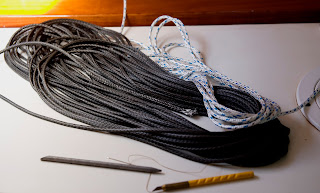 New Dyneema
New Dyneema
One of the old halyards, the blue jib halyard, was pulled out of the mast to start the project.
 Old Blue Wire and Rope Halyard
Old Blue Wire and Rope Halyard
The first thing to do was to try to push a fid through the core. We got this far, but it was soon evident that going all the way was impossible.
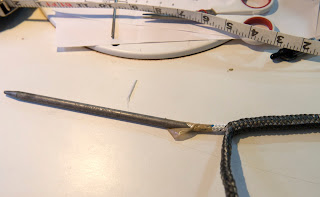 Trying a fid
Note:
Trying a fid
Note: What makes this process difficult is that it is similar to the old Chinese finger\puzzle trick. When trying to pass one rope through the inside of another, if the outside rope is pulled a little bit, it squeezes on the one on the inside and which jams and cannot be pulled any further. Any snag or lump, even a piece of tape, on the inside rope can cause the outside one to squeeze. This is why we used a string, which is too small to cause a jam, or a very smooth joint when connecting any line which would be used to pull another through a core or a cover.
After some other tries, we decided to use an old antenna to lead a string through. The ball on the end was easy to guide through the middle of the core. (One issue with the fid was that it often snagged a yarn and went on the wrong side, jamming the process.)
 Antenna Ball
Antenna Ball
The antenna could easily be pushed through the Dyneema core.
 Pushing into the core
Pushing into the core
A string was tied to the Antenna and it was tied to the filler, using a very smooth and tapered knot covered with smooth tape.
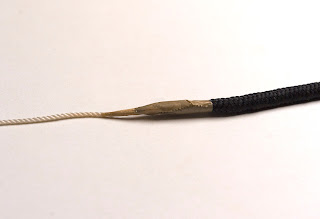 String is Tied to core
String is Tied to core
The string, tied to the antenna was soon being pulled into, and through, the Dyneema. This string was then used to pull the filler into the Dyneema.
 String going into core
String going into core
Once the filler was inside the Dyneema we pulled the Dyneema, with the filler inside it, into the cover by pulling it with the old polyester core. Note how the Dyneema is sewed to the old white core. This was the only way we could prevent the joint from jamming.
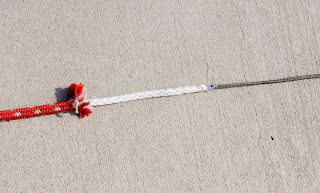 Cores fastened together
Cores fastened together
Pulling 130 feet of bulked Dyneema into the cover required lots of "milking" which was best done on the dock with all the lines stretched out and the one going inside tied off to the dock at its end.
wingssail images-judy jensen
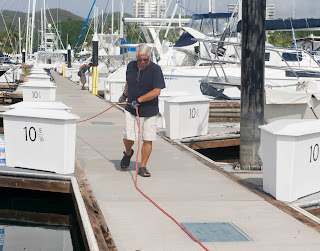 Working on the dock
Working on the dock
I used gloves and worked for a while milking the cover over the Dyneema.
wingssail images-judy jensen
 Milking the cover
Milking the cover
When everything else was done, and the splices finished, I installed the shackle.
 Shackle installed
Shackle installed
And added a tail (white) and a reeving eye for putting the halyard into or out of the mast.
 Reeving eye on the tail
Reeving eye on the tail
Here is a finished halyard, the port spinnaker halyard (red).
 Finished Red Halyard
Finished Red Halyard
The cover and filler start where the halyard goes into the sheet stopper when fully hoisted. The splice to bury the cover (the taper) is visible.
 Sheet Stopper and taper
Sheet Stopper and taper
Not easy to see, (an not, I guess, very informative even if you could see it, here are four new halyards shackled to the boat.
 Four New Halyards
Four New Halyards
 Green
Green
 Blue
Blue
This little pile of wire is what we took off the boat. It's much heavier than the Dyneema we put on.
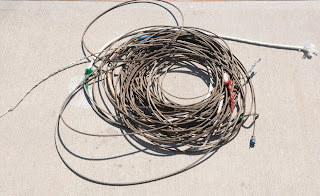 Old Wire
Old Wire
We know there will be problems with this conversion, ones we didn't think of. Here is the first we discovered: If you accidentally let go of a halyard now, you have a real problem. Previously if you let go of a halyard it would simply dangle out to the leeward side of the boat until somebody grabbed it. Now the rope portion is much heavier than the Dyneema and the shackle so if you let go of the shackle, the rope, being heavier, immediately pulls the halyard to the top of the mast. If we do this somebody will have to go aloft and pull it down. Ouch!
Labels: Boat Work
 Bringing the Mainsail South
Bringing the Mainsail South New Main-First Test Sail
New Main-First Test Sail Looking up the Mast
Looking up the Mast Main
Main White Side of New Main
White Side of New Main Used North #2 Genoa (this sail needs some work)
Used North #2 Genoa (this sail needs some work)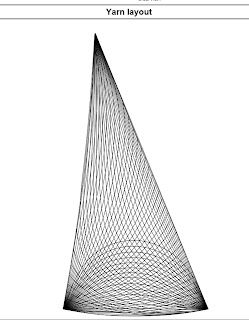 Proposed #1 Genoa Design
Proposed #1 Genoa Design The Last Generation: The Golden Sails (we loved these sails)
The Last Generation: The Golden Sails (we loved these sails) Great Sailing on Banderas Bay
Great Sailing on Banderas Bay New Dyneema
New Dyneema Old Blue Wire and Rope Halyard
Old Blue Wire and Rope Halyard Trying a fid
Trying a fid Antenna Ball
Antenna Ball Pushing into the core
Pushing into the core String is Tied to core
String is Tied to core String going into core
String going into core Cores fastened together
Cores fastened together Working on the dock
Working on the dock Milking the cover
Milking the cover Shackle installed
Shackle installed Reeving eye on the tail
Reeving eye on the tail Finished Red Halyard
Finished Red Halyard Sheet Stopper and taper
Sheet Stopper and taper Four New Halyards
Four New Halyards Green
Green Blue
Blue Old Wire
Old Wire.jpg)
